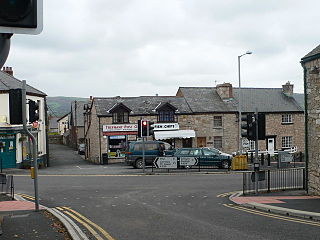
St Asaph is a city and community on the River Elwy in Denbighshire, Wales. In the 2011 Census it had a population of 3,355, making it the second-smallest city in Britain in terms of population and urban area. It is in the historic county of Flintshire.

Denbigh is a market town and a community in Denbighshire, Wales. Formerly, the county town, the Welsh name translates to "Little Fortress"; a reference to its historic castle. Denbigh lies near the Clwydian Hills.

Abergwili is a village and community in Carmarthenshire, Wales, near the confluence of the rivers Towy and Gwili, close to the town of Carmarthen. It is also an electoral ward. The community includes the settlements of Peniel, Llanfihangel-uwch-Gwili and White Mill. The grounds of the former Bishop's Palace are listed on the Cadw/ICOMOS Register of Parks and Gardens of Special Historic Interest in Wales.

North Wales is a region of Wales, encompassing its northernmost areas. It borders Mid Wales to the south, England to the east, and the Irish Sea to the north and west. The area is highly mountainous and rural, with Snowdonia National Park and the Clwydian Range and Dee Valley, known for its mountains, waterfalls and trails, wholly within the region. Its population is concentrated in the north-east and northern coastal areas, with significant Welsh-speaking populations in its western and rural areas. North Wales is imprecisely defined, lacking any exact definition or administrative structure. It is commonly defined administratively as its six most northern principal areas, but other definitions exist, with Montgomeryshire historically considered to be part of the region.

The Bishop of St Asaph heads the Church in Wales diocese of St Asaph.
Gwilym Owen Williams was a prominent figure in the Church in Wales who served as Bishop of Bangor from 1957 to 1982 and Archbishop of Wales from 1971 to 1982.

Cwm railway station served the village of Cwm in Monmouthshire, Wales.
Kerry is a village and geographically large community in Montgomeryshire, Powys, Wales.
Tollcross station was a railway station in the east end of Glasgow, Scotland. It was opened by the Caledonian Railway as Tollcross on 1 February 1897.

The Cathedral Church of Saints Asaph and Cyndeyrn, commonly called St Asaph Cathedral, is a cathedral in St Asaph, Denbighshire, north Wales. It is the episcopal seat of the Bishop of St Asaph. The cathedral dates back 1,400 years, while the current building dates from the 13th century. The cathedral is part of the Church in Wales and part of the Anglican Communion of Wales.
The Vale of Clwyd Railway (VoCR) was a standard-gauge line which connected the towns of Rhyl and Denbigh via St Asaph in North Wales.

Trefnant is a village and community in Denbighshire, Wales. It is located on the A525 road in the Vale of Clwyd, about halfway between St Asaph (Llanelwy) to the north and Denbigh to the south. At the 2001 Census, the community had a population of 1,409, increasing to 1,581 at the 2011 Census.
Newbridge on Wye railway station stood on the single-tracked Mid Wales Railway between Builth Wells and Rhayader. It was closed on 31 December 1962 and the trackbed removed. The site has been cleared and now contains senior citizens' housing. An overbridge which formed the entry point to the station from the south is still in place.
Tydd railway station was a station, opened by the Peterborough, Wisbech and Sutton Bridge Railway on 1 August 1866, in Lincolnshire serving the villages of Tydd St Mary, Tydd Gote and Tydd St Giles, Cambridgeshire on the Midland and Great Northern Joint Railway route between Sutton Bridge and Wisbech. It closed on 2 March 1959.

Rhostryfan railway station was the intermediate station on the Bryngwyn Branch of the North Wales Narrow Gauge Railways (NWNGR) and its successor the Welsh Highland Railway (WHR). At some time since closure, the station itself has been demolished.

Rhosymedre is a village within the community of Cefn, in Wrexham County Borough, Wales.

Doldowlod railway station stood on the Mid Wales Railway between Builth Wells and Rhayader. It was closed on 31 December 1962 and the track removed.

Llandderfel is a village and a sparsely populated community in Gwynedd, Wales, near Bala, formerly served by the Llandderfel railway station. The community also includes the settlements of Glan-yr-afon, Llanfor, Cefnddwysarn and Frongoch. The Community population taken at the 2011 census was 1,095.

Hookagate and Redhill railway station was a station in Hook-a-Gate, Shropshire, England. The station was opened in 1911 and closed in 1933.

Porthywaen Halt railway station was a station in Porth-y-waen, Shropshire, England, on the Tanat Valley Railway and the Potteries, Shrewsbury and North Wales Railway. The station opened in 1904 and closed in 1951. The short platform had a shelter and there was also signal box at the east end which controlled access to the quarry branches. Cambrian Heritage Railways has plans to re-open the station as part of its aim of reopening the line from Gobowen to Blodwel. The platform is still extant.














